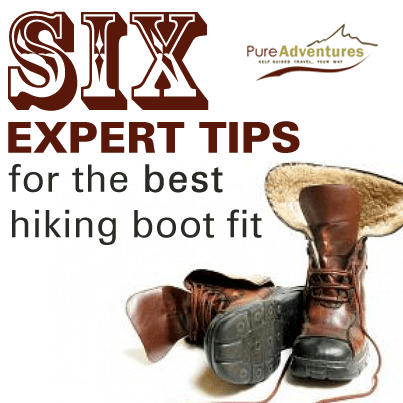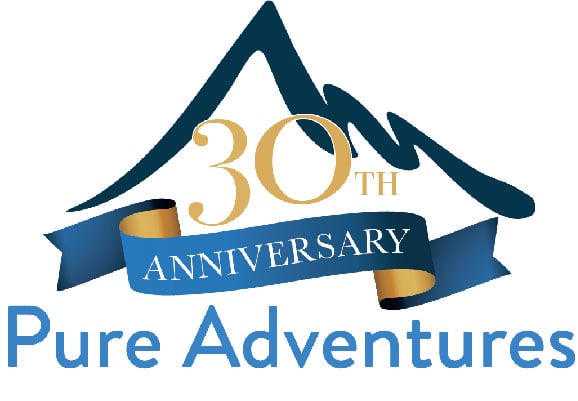
Six Expert Tips for Perfect Fitting Hiking Boots
The most important hiking gear you will ever buy is a pair well fitting boots. Proper fitting boots will ensure that your feet will remain blister free so that you enjoy your hiking adventures, whether you’re taking on the trails around your home, or on one of our self-guided hiking tours in Europe, Japan, or the USA . After you’ve bought your boots, lacing techniques and dry feet ensure your feet stay healthy for the duration of your hike. Elaine Brewer, long time runner and boot fit expert, shares her tips for happy and healthy feet.
Surprising Boot Fit Tricks
Bring the socks you would wear out on the trails into the store and try on the boots with them. Despite how you may have bought or tried to fit your hiking boots in the past, don’t try to feel how much space is between your toes and the front of the boot (“now wiggle your toes…” – it doesn’t work well. Instead, with laces untied, stand up and tap your toe on the ground a few times. Still standing, feel behind your heel. You should be able to fit two fingers comfortably between your heel and the back of the boot. When you lace up, walk around. There should be the slightest of lift on your heels. This is good and actually reduces blisters because you have room for your feet to swell (and they will swell!). Make sure there are no big gaps or tight squeezes between your foot and the boot. Walk around the store for awhile to get a really good feel. Head over to their pack department – if you can – and try on a weighted pack with your boots to feel the difference in weight.
Lace Up (and sometimes down)
Think Goldie Locks here – not too tight, not too loose…just right. Brewer tends to change up by lacing pressure as she goes from the toe of the boot to the ankle. If you do this, secure the pressure difference by tying a surgeon’s knot. This puts friction on the lace without putting an actual knot in it so that the lace doesn’t slip. She also tends not to tie the finishing knot at the very top of her boot since this causes a lot of pressure on the ankle and lower shin – which can cause host spots and blistering. Instead, she advises that hikers weave their laces from the top downwards. She actually ties her knots a level below what most hikers do.
Loosen Up (your laces that is)
Your feet swell the longer you are hiking. Every couple of hours, untie your boots and loosen the laces as needed. Do you end up with purple toenails that fall out after a big hike? You’re not alone! If you’re going downhill a lot and bumping your toes, try changing up the lacing pressure: put more pressure on the front of your boot, tie it off with a surgeon’s knot, and then loosen the rest of the way up. Your toes and their nails will thank you.
Keep ’em Dry
On really long or strenuous hikes, Brewer covers her feet with Body Glide before putting on her socks. Alternatively, you can use a foot powder. By putting baby powder on your feet before you put on socks, the powder can help suck up any moisture – moisture being a catalyst for blisters forming. On overnight trips, Brewer advises putting newspaper in your boots overnight – the newspaper helps dry them out.
Keep ’em Clean
Change your socks every day. Even if they look clean, there will be dirt in the fibers that can irritate your feet. You’ll appreciate clean socks even more if the socks you wore the previous day are still wet. Brewer recommends wool socks. When wet, wool socks will wick away moisture so your feet are relatively dry, compared to wearing cotton or synthetic socks.
With these six expert tips for perfect-fitting hiking boots, you are sure to keep your toes and feet happy as you embark on your next hiking adventure. If you would like some suggestions on some of the best places to go hiking, drop us a line and we can help you out. Our experts have been hiking all over the world and can put together the hiking trip of your dreams! Contact us to learn more!
